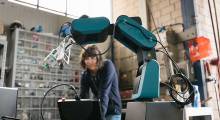Editor’s note: The following column by Derek Rickard, sales manager, Cimcorp Automation Ltd., is part of Modern’s Other Voices column, a series featuring ideas, opinions and insights from end-users, analysts, systems integrators and OEMs. Click here to learn about submitting a column for consideration.
————-
On-the-job danger is particularly high for people who work in warehouses and distribution centers. The risk is even greater in traditional facilities where employees pick and prepare all orders by hand. When fulfilling orders manually, warehouse workers have to repeatedly twist, bend, reach and lift heavy objects—all activities that put considerable strain on the human body.
These strenuous activities can cause not only immediate, short-term injuries to muscles, tendons, joints and nerves. They can also lead to long-term damage and chronic pain, including conditions like repetitive stress injuries, repetitive motion injuries, musculoskeletal disorders, cumulative trauma disorders, and cumulative trauma injuries.
Growing risks amid labor shortages and operational challenges
For jobseekers and recent graduates, the rigorous physical demands and ergonomic risks often make materials handling less appealing as a potential career path—a major issue contributing to the labor shortages that currently plague warehouses and distribution centers around the world.
These shortages only add on to the multitude of operational challenges facing facilities today: managing growing inventories due to SKU proliferation; meeting greater consumer demands; and keeping up with the wave of sales during busy peak seasons. As these issues compound, existing staff must work harder, faster and longer to keep orders moving out the door on time and with accuracy—ultimately raising their likelihood of injury even higher.
In an effort to mitigate the ergonomic risks inherent with manual handling, many companies have taken steps to provide warehouse employees with better training on proper lifting and handling techniques. Further, governments around the world have implemented regulations aimed to improve workplace safety, such as the European Union’s Directive 90/269/EEC and the United States’ Occupational Safety and Health Act. Training programs and regulatory standards, however, can only go so far. Warehouses and distribution centers should explore automation as a way to drastically improve safety while optimizing operations.
Run better, faster and safer with automation
Automated systems available today can take over many of the physically demanding tasks involved with order fulfillment. Advanced robotics controlled by intelligent software can rapidly and accurately receive, store, pick, pack and ship orders—optimizing material flow across the entire warehouse.
These systems include:
● Automated guided vehicles (AGVs)
● Conveyor systems
● Automated storage and retrieval systems (AS/RSs)
● Order picking solutions
By bringing in automation, warehouses can fill in the void created by labor shortages while improving working conditions for current employees. Staff no longer have to overexert themselves performing repetitive tasks and strenuous motions, which significantly reduces the risk of on-the-job injuries. And in turn, fewer injuries means less worker compensation costs, liability costs and potential litigation costs—a win/win for companies and their staff.
In addition to improving safety, automated systems also help facilities run with utmost efficiency to overcome their toughest operational challenges. The right equipment can provide the speed and accuracy needed to keep up with increased demands and seasonal peaks, while maximizing the use of available storage space.
Take an automated goods-to-person solution, for example. An AS/RS and shuttle system transports goods in totes, bins or trays directly to employees positioned at ergonomic picking-stations, and then returns them to high-density storage after the required items are picked. This type of system is safe, fast, accurate and up to six times more efficient than manual picking alone.
Reinventing the role of the warehouse worker
In an automated facility, employees can take on more sophisticated job duties. Rather than spending the workday running up and down aisles, transporting items in and out of storage, and lifting heavy crates and boxes, staff can be assigned to new, value-added roles.
These include:
● Operating equipment
● Supervising automated operations
● Reviewing performance data
● Releasing orders
● Selecting picking sequences
● Transport planning
● Stepping in for products with special handling requirements
These engaging, technical roles are safer for existing staff and bring much needed appeal to careers in materials handling. They can attract a new generation of tech-savvy jobseekers to fill the labor shortage gap.
With so many automation solutions available today, look to a technology provider that can analyze your current operations to determine what systems are best for your facility. By investing in the right technology, you can cultivate a culture of safety in a modern warehouse, equipped to easily meet the rising demands of order fulfillment.
Article topics








